By Jeffrey A. Rendall, Photos by Kevin Gaydosh
CHAPEL HILL, NC – School pride – it’s just something that goes along with a university.
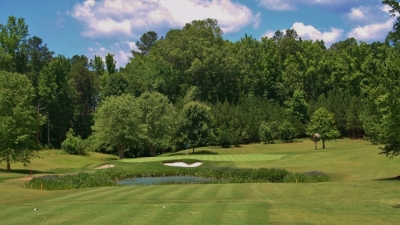 |
| The beautiful par three 14th hole at UNC Finley. |
It’s natural for people to want the best for their school, and that certainly extends to its sports facilities. Such was the thinking behind bringing in Tom Fazio to design a completely new golf course at the University of North Carolina (known as UNC Finley, which opened in 1999) at Chapel Hill.
UNC’s original Finley course opened in 1949 (a George Cobb design), which made use of a roughed-out nine-hole course built by the WWII Army Air Corps Pre-Flight Training school that was located at UNC Chapel Hill. The layout was so flat – and dare we say it, boring – that locals used to refer to it as “Finley flats.”
The “Finley” part comes from Raleigh businessman A.E. Finley, who donated the machinery and labor needed to build the course, and then made ongoing contributions through his charitable foundation to help maintain it. Finley also built the course’s original clubhouse, which was finished in 1952.
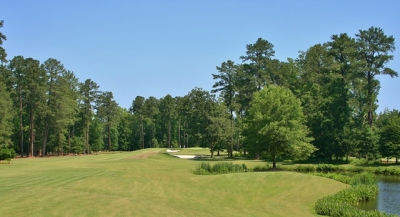 |
| The par four 2nd has a raised green that will test you on the approach shot. |
It was all well and good – not every university has its own golf course, after all -- but UNC’s alumni wanted a golf facility to match the university’s sterling sports reputation that could also serve as home to the golf teams.
Fazio said that he’s not officially affiliated with the university, but has a lot of friends and associates there who wanted him for the job. “It was interesting, when I went to the first meeting of the committee, there were twenty people in the room who I knew very well – and many of them were past clients that I had done golf courses for. It was kind of like a homecoming.”
Among the meeting attendees were Dean Smith and Buck Adams… just to name a couple.
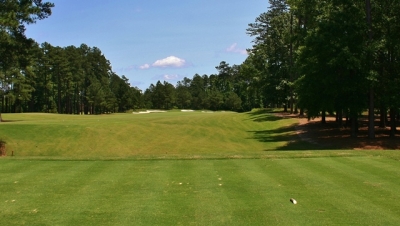 |
| The par four 10th hole doglegs sharply right, making club selection from the tee challenging. |
Fazio continues, “They wanted to upgrade Finley for many reasons. All of their sports facilities were being looked at and evaluated at the time. Plus, there’s so much competition in the marketplace. With golf being such a high profile sporting structure for their university, it was a group of alumni people who basically asked, ‘why wouldn’t we have a university golf course that would be as good as any of the other university courses?’”
“The Dean dome got built (and expanded in 2000), the new basketball facilities. And they were also doing many other sports related complexes. So golf became a logical category for the alumni who were golf people to say, look, we want to help and participate to get this thing into today’s modern standards of highly accepted golf facilities.”
Once the decision was made to upgrade the university’s golf facilities, all involved agreed that it had to be a head-to-toe operation. For that reason, the “new” Finley course is just that – completely original.
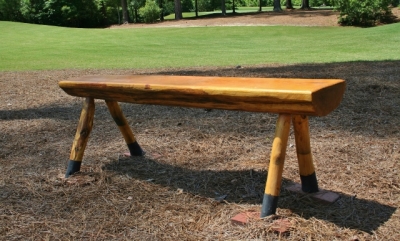 |
| UNC Finley is quite walker-friendly, but everyone can use a rest now and then. |
“It was not a renovation or a restoration,” Fazio recalled. “It was one of those cases where you essentially blow-up what was there and build a completely new golf courses on top of it.”
Several of the new holes do share some of the old corridors from the previous course, but there’s nothing on the new Finley that you’d recognize from the old course. A lot of new land was added as well. Fazio cleared an additional 45 acres of trees and moved 345,000 cubic yards of earth to create elevations in the course that didn’t previously exist.
So much for the old “Finley flats” moniker. The newest section of land is also quite sloped, where current players experience the back nine.
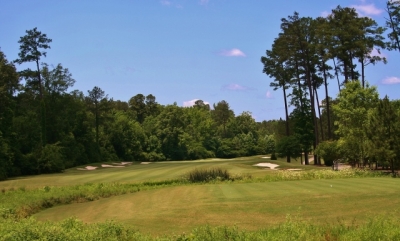 |
| From the back sets of tees, the par five 13th offers the most intimidating tee shot on the course. |
Other changes: the new course was 800 yards longer and the new practice area was about four times the size of the old one. In other words, the new Finley was fitting for the university and suitable for the school’s golf teams – meeting a very important goal.
But the modernized and improved layout wasn’t just for the golf team players, Fazio insisted. “The kids that are coming to play the golf course for the team are all very good players, but it’s important to design a course that would be playable and enjoyable for all levels of players at the university.”
“For me as a designer, no matter what people would tell me they want – I’ve always believed that I know a lot more about what they want than they think they do, because the golf course was not meant to be hard or difficult golf. It relates to my overall design philosophy – no matter what the program is, it has to be for all levels of players.”
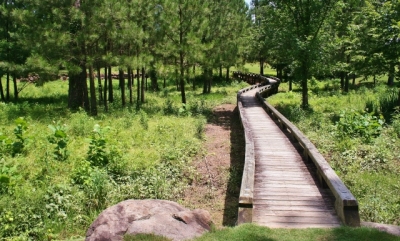 |
| This bridge is not part of a walking trail -- it leads to the back tees on the par five 13th. |
“I’m a believer that, no matter where it is, if good players (meaning low handicappers) don’t like a golf course, then no one’s going to like it. That doesn’t mean a course has to be hard – that’s just the fine line on how to create a golf course that should and must be for every level,” Fazio added.
Fazio went on to explain that the golf course set-up can always be strengthened for competitions, but on an everyday basis, everyone in the university community can compete.
And because all of those players have access to the course, Finley receives a lot of play. That too, was part of the overall plan.
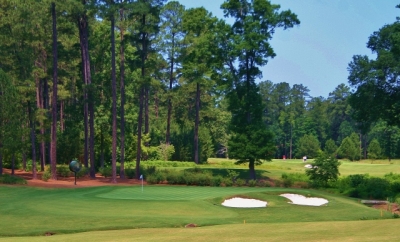 |
| At 224-yards from the back tee, the par three 5th hole demands length and accuracy. |
“Based on the climatic conditions of that region, it’s conceivable that the course will be used year-round,” Fazio explained. “You have to account for that when you’re laying out the golf course – the foot traffic, cart traffic, ball marks on the greens, sun angles…”
Whatever the combination, it seems to work well at Finley. Fazio says they’ve done a tremendous job in maintaining the course – and sure enough, the day we played, the course conditions were excellent, about what you’d find at a high-end daily fee.
The course does play long – over 7300 yards -- from the back tees. Finley’s greens are large so as to accommodate a great variety of pin locations, which is part of the set-up options that Fazio alluded to earlier.
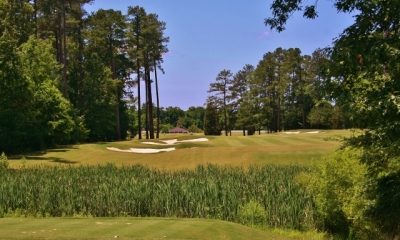 |
| Avoiding the left-side fairway bunkers is crucial on the par four 11th hole. |
Fairway bunkers are large and deep, so if you’re a little wide of the short stuff, you’ll likely pay a price. Ditto for the greenside bunkers, some of which also have grass noses protruding into them – you could end up with a very odd stance as a result.
But not everyone has to face the daunting yardage that the golf teams must endure. Multiple teeing areas reduce the length for shorter hitters and everyday players. From these locations, forced carries are all-but eliminated. Greens complexes are open in front, so there’s always the favored run-up option.
Fairway widths are also quite generous on most holes and the roughs are trimmed to a very manageable height – long enough to stop your ball from reaching the extremes, and short enough where you can advance the ball a good distance.
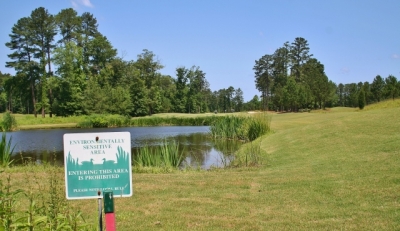 |
| UNC Finley is very natural - and environmentally sensitive. Here, the par five 6th. |
The course is also very walk-able, and not just for the young folks who are in good shape. The back nine does have some real elevation variation, but not nearly enough to prevent you from lugging your bag. Tees are located near greens – very walker-friendly, generally.
UNC Finley’s Head Golf Professional, Michael Wilkinson, describes the highlight holes:
“I think on the front, the par four second comes up first to me as challenging. It’s a short hole, only 343 from the back tees, but the green is elevated and it’s hard to see the bottom of the flag and hard to get it close.
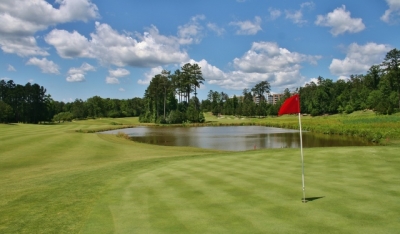 |
| From behind the flag of the long and challenging par four 15th. |
“The fifth hole is a longish par three of 224-yards from the back tees to a green that sits downhill from you. Wind can swirl there, making club selection difficult. The hazard to the right of the green is always in play if you push your shot.
“The ninth is a classic dogleg right par four of 458 yards, and the prevailing southwest wind is always in your face. The hole plays longer than its yardage and there is water along the length of the hole for your second shot. The back left hole location is difficult because you cannot see the bottom of the flagstick due to a deep greenside bunker. Get into it and you are looking at a shot directly toward the water.
“But once you start the back nine, the test intensifies. The tenth hole is a long dogleg right par four that turns sharply at the bend of the fairway. Driver is a difficult play off the tee, as it is easy to hit through the fairway if you don’t turn it. But hitting anything less than driver will leave you with a second shot of over 200 yards to an elevated green. Par is a great score here.
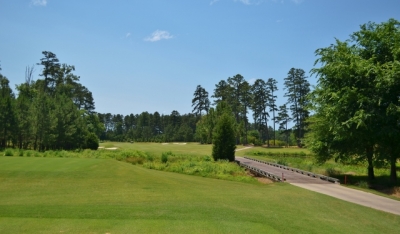 |
| The short par four 7th offers a good birdie opportunity if you avoid the trouble off the tee. |
“The par four fifteenth is a picturesque hole that is on the cover of our course brochure. Measuring 498-yards from the back tees -- and from an elevated tee -- this par four has water down the entire length of the left side of the hole. The water then juts in at the green, making a back left hole location a shot over the water to the green. The two-tiered green is also difficult to read. Par is a good score here.
“The par four sixteenth is a bear. It’s 449-yards long, with an uphill second shot. The tee shot requires a forced carry from every tee except the most upfront red tee. There’s bunkering on the right side and dense forest on the left, which makes accuracy from the tee a premium.
“The uphill second shot is as much as two clubs difference in yardage -- and if playing into the wind, wow, what a challenge. The green is difficult to hold, so over the green is a common occurrence. Finally, short and left of the green is death (deep bunkering to the elevated green makes it almost impossible to get the shot close).
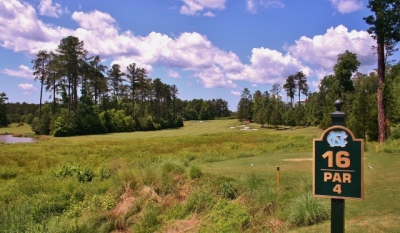 |
| The difficult par four 16th hole has earned its #1 handicap designation. |
“Finally, the seventeenth hole. On some early drawings, Fazio had the hole with two greens. As the construction process continued, it was decided to have the greens together -- but with a 5-foot drop between the two halves. The hole actually plays two different ways: from the tee to the middle length par 5 of 560 yards, the play is out to the dogleg slightly left of the center of the fairway. This position gives you a look at the green and will allow you to see where the flag is located.
“If the flag is on the upper left side of the green, you play over and left of the deep fairway bunkers in the middle of the landing areas. If the flag is located on the lower right side of the green, you play down the right side, which is narrower and guarded by the dense forest on the right and the deep fairway bunkers on the left. The upper hole location is easier. Birdie can be made, but if you are on the wrong side of the fairway as you approach the green, par is a good score.”
Kudos to Wilkinson for the descriptions – we couldn’t have said it better ourselves.
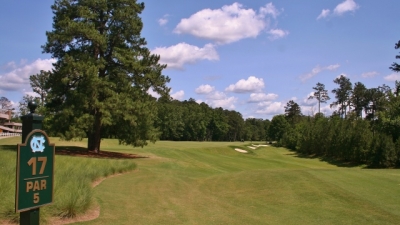 |
| The par five 17th hole will probably take a couple tries before learning how to approach it properly. |
Since its opening in 1999, there’s been very little change to the “new” Finley layout, but the university just completed a year-long renovation of the clubhouse. The work doubled the size of the building and added new locker rooms for the men and women as well as a full-service restaurant.
What does Wilkinson want you to leave with? How about a little school spirit.
“We want most of all for the golfer to want to come back. As was the case with the recent NC Golf Panel group, the best compliment we can get is that UNC Finley is a course that could be played every day and you would not get tired of it. With the recent clubhouse renovation, we have a place that people can finish and still enjoy the entire facility.”
All in all, not a bad way to spend the day at the ‘ol school.
Where we Stayed
The Hilton Garden Inn Durham Southpoint hotel is conveniently located off I-40 and within close proximity to Durham, Chapel Hill and RDU International Airport. Across from The Streets at Southpoint mall, the hotel is loaded with amenities for the comfort of all guests. Its rooms are furnished with a spacious work desk and Herman Miller Mirra® ergonomic desk chair, two phones, voicemail and complimentary wired and wireless high-speed internet access.
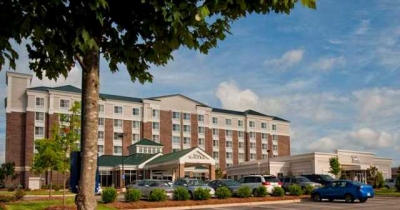 |
Standard in every room is a 32-inch LCD HD TV, along with a hospitality center complete with microwave, refrigerator and coffee maker. Call 919-544-6000 or visit http://hiltongardeninn3.hilton.com/en/hotels/north-carolina/hilton-garden-inn-durham-southpoint-RDUSPGI/index.html
Note: We would especially like to commend the staff at the hotel, which went out of their way on several occasions to make our stay comfortable and relaxing. When combined with the hotel’s central location to a number of great courses in the Triangle area, it’s an excellent place to stay for golfers visiting North Carolina.
Summit Hospitality owns and operates 15 hotels in the Triangle, Charlotte, Pinehurst and Wilmington as a franchisee of Marriott, Hilton and Hyatt brands. It also offers golf packages at various properties. www.SummitHospitality.com
Details:
UNC Finley Golf Course
500 Finley Golf Course Rd.
P.O. Box 2675
Chapel Hill, NC 27517
Phone: 919-962-2349
FAX: 919-843-5974
Course Designer: Tom Fazio
Director of Golf: Johnny Cake
Head Golf Professional: Michael Wilkinson
Director of Golf Course Maintenance: Ross Fowler
Golf Course Superintendent: Mark Steffer
Website: www.UNCfinley.com
Tee times up to 7 days in advance and online specials at Golfnow.com
Tees/Yardage/Slope/Rating
Tar Heel 7349 141/75.0
Gold 6844 137/73.1
Blue 6231 127/70.1
White 5648 122/67.4
Red 4980 120/68.8
Rates:
Check the website for current rates. Online specials are also available through GolfNow (click the banner above). UNC Finley was recently voted by the GolfNow triangle members as their number one golf course to play.
| Related Links | Comments on this article? | |
|
Maryland National Golf Club Hollow Creek Golf Club Rocky Gap Resort PB Dye Golf Club in Ijamsville Whiskey Creek Golf Club |
E-mail Jeff Rendall, Editor: jrendall@golftheunitedstates.com |











